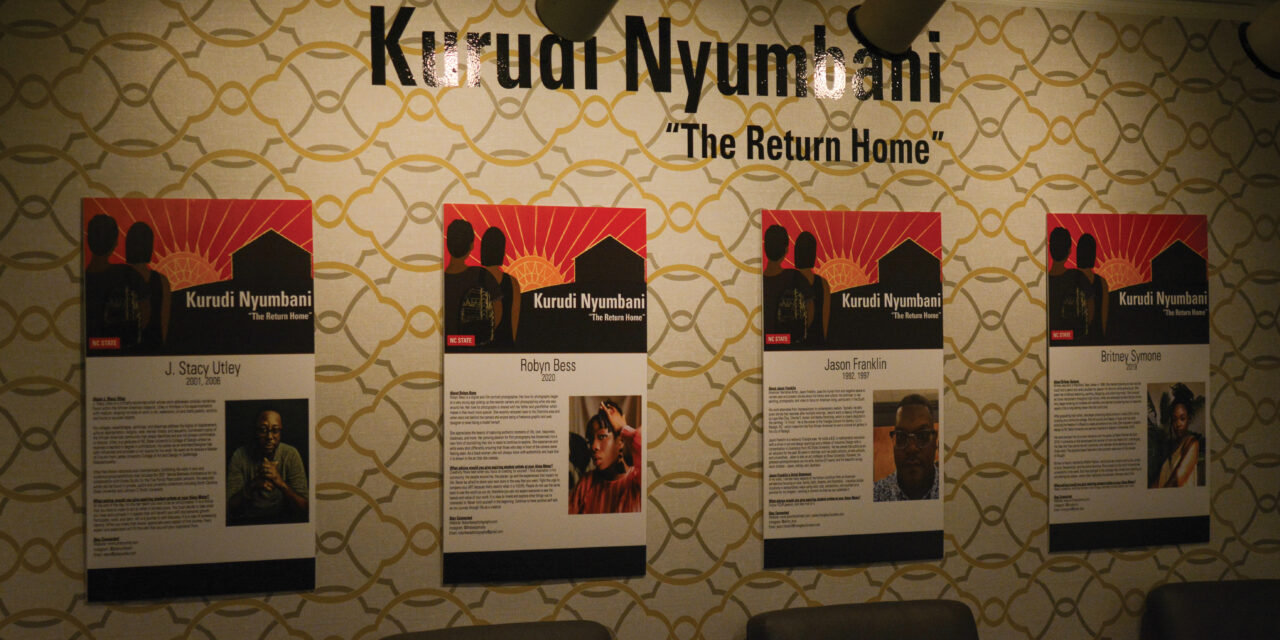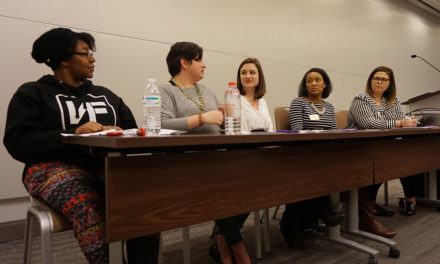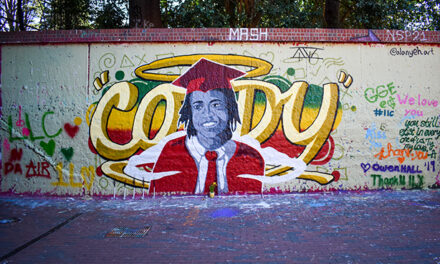On Oct. 25, the African American Cultural Center (AACC) hosted an opening reception for their second art gallery of the 2021-2022 academic year. The gallery is entitled “Kurudi Nyumbani,” which is Swahili for the return home. The AACC chose this exhibit theme to highlight the 30th anniversary of the center’s existence at NC State and the idea of homecoming during Red and White week.
The gallery featured art from four Black alumni: J. Stacy Utley (‘01, ‘06), Britney Symone (‘19), Jason Franklin (‘92, ‘97) and Robyn Bess (‘20). Their art highlights personal themes of being seen, living authentically as a Black woman and understanding the Black experience through the good and the bad.
The event began with Isaiah Lucas, Program Coordinator of the AACC, welcoming the guests to the gallery and giving an introduction on the featured artists. Lucas then hosted a Q&A discussion with three of the artists in the format of a talk show which was entitled “#trusttheprocess.”
Isaiah Lucas: What does your art mean to you and your identity?
Robyn Bess: Me as an artist, my identity is me as a Black woman. As a dark skinned woman I saw experiences where I wasn’t being seen on camera.
Jason Franklin: [My art] is about these quiet moments… When we talk about the Black Lives Matter movement we think about death and these bad moments. I want to flip that and talk about the future.
Britney Symone: I enjoy creating something out of nothing. [My work] is about celebrating emotional release and vulnerability, especially with Black women.
IL: What does the show name, #trusttheprocess, mean to you in terms of your art and your experiences?
BS: It means taking everything day by day and making slow and steady progress. Everything takes time no matter what it is and what you’re trying to achieve. It just comes down to having faith in yourself and knowing that you’ll get there as long as you’re doing the work to get there.
RB: Between the pandemic and 2021, I’ve done a lot of self work and made a lot of [personal] goals. [#trusttheprocess] is trusting in yourself and the work that you do. As long as the intention is there you can get a long way. It is understanding that you need support in the beginning and getting to that place of confidence.
JF: It is the God in me that allows me to have remnants of Him in the things I created. It’s learning from the failure and getting back up and acknowledging that it didn’t work… The whole process of failing miserably can be the birth of something beautiful.
IL: With the AACC celebrating 30 years on NC State’s campus and having the theme Kurudi Nyumbani “the return home,” how does it feel to be back at NC State?
RB: It feels surreal especially because I graduated during the pandemic. I was feeling robbed of a lot of things in my last semester. It is great and honoring to come back to campus and still be recognized as a photographer.
BS: It is an honor to be invited back to share my work and my story and what I do as an artist.
JF: It feels nice being recognized like this. I’m from the Triangle area and sometimes people don’t acknowledge you back home, but it is beautiful to be acknowledged at home.
IL: What were some of your experiences at NC State and how has that affected where you are now?
BS: There were plenty of experiences and opportunities that going to NC State opened up to me. I felt seen by the [AACC] and [the Office for Institutional Equity and Diversity]. It showed me what I was capable of.
JF: There was a studio I went to downtown every day. I was always there after class. Making relationships with professors is a lifelong commitment…[Meeting my wife in college and] having her support allowed me to build and open my gallery.
RB: If you want to be in fully Black spaces you can do that. There was a time when I only wanted to be surrounded by people who looked like me. [I felt like] advocating myself was easy [at NC State] because it was about what I can provide. I worked with Multicultural Student Affairs. I was working on my craft while I was getting paid to do so. If you put in the work and build the community here, you can come out strong.
IL: How does your work center the Black experience?
BS: I do this by putting us at the forefront. Expressing the feeling of Black women having to be strong all the time and not being allowed to express our needs or our emotions in a healthy way. [My art] pushes us to try to allow those emotions and what we feel about the society we’re in.
JF: That’s all I tell. I’m a Black man, how can I not tell the Black experience. I explore this in my piece “Free.” How often do you see images of young Black boys unbound and happy and they can just be? There is a lot of pain and suffering in the Black experience but there is also a lot of peace and grace. I want to show that as well.
RB: All of my models are dark skinned Black people. I am inspired by those people and their personalities. I want Black people and dark skinned people to feel seen and that they matter. The biggest thing I want is to not be ignored.
IL: Do you have any advice for students who want to be artists?
BS: If you are already creating things, then you are an artist. If one person likes your art, that’s enough. Even if that one person is you.
RB: The importance of building community and asking for help. You have people around you that want to support you and that makes things go by so much easier. It’s nothing to drop people who aren’t for you. If something is not serving you, you can leave it. Be sure to trust yourself at the beginning of it all.
JF: Be authentic. Find your visual and creative voice. At some point you’ll have to leave the mimicking and dive into the unknown, dive into the core of who you are.There’s only one you and you only have one authentic voice. Make it beautiful. Make it unique.
At this point of the event, Lucas opened up the questions to the audience. Questions were asked by Amaya Abraham, a third year student in Art & Design, and Katrina Franklin, the Chief Operations Officer of Triangle Cultural Art Gallery. Here are two questions from the several they asked.
Katrina Franklin: Where do you see yourself going in the future? How will you grow as artists?
BS: I want to go freelance. I’m still figuring out what works for me. I am a graphic designer and I still want to be. I’ll just follow whatever comes to me.
RB: I want to get out of service photography. I want more print worthy fine art where people can put these in their house. I’m getting into film photography. I want to feel something when I look at my art.
JF: I see myself mixing more difficult mediums together to create different layers, like with drawing and painting. I’m also taking a larger interest in Black women for my next series.
Amaya Abraham: It has been said that an artist’s duty is to reflect the times. Is that something you accept.? If you have questioned your duty as an artist how do you reassure yourself?
JF: I accept that. I want to have my imprint on what’s happening in the world.
BS: I reflect on the times of my own life. I think artists reflect how they feel about what’s going on in their lives and what’s going on in the world.
RB: I’m inspired by the people around me so my work is more personal. For example, my series was called “Isolation” and while it was during the pandemic, it was not about being in a pandemic. I want to create timeless pieces that resonate with people.
The opening reception seemed to leave space for introspection as the artists revealed truths about themselves and their work, especially as it related to Blackness. Kurudi Nyumbani will run through Dec. 3, 2021 from 8 a.m. to 5 p.m., Monday through Friday, at the AACC Gallery at Witherspoon.




